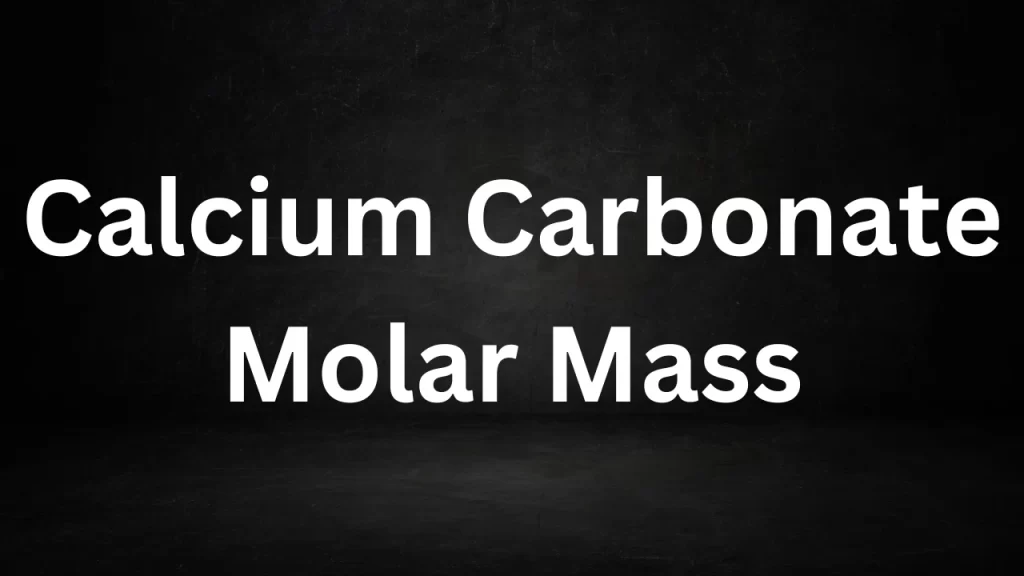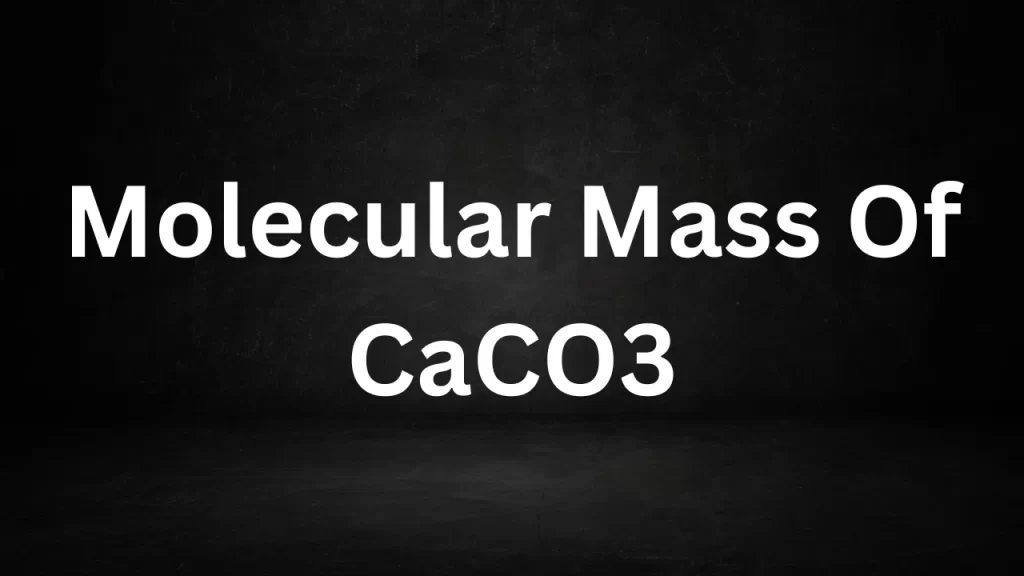Tag: Molecular Mass Of CaCO3
Calcium Carbonate Molar Mass
Calcium Carbonate Molar Mass: Calcium carbonate is a chemical compound that plays a crucial role in various aspects of our lives, from its presence in natural formations like limestone and marble to its use in industries such as agriculture, construction, and medicine.
One fundamental concept in chemistry that helps us understand and work with calcium carbonate is its molar mass. In this article, we will explore what molar mass is, how it relates to calcium carbonate, and its significance in various applications.

Calcium Carbonate Molar Mass
What Is Molar Mass?
Molar mass, also known as molecular weight, is a fundamental concept in chemistry that refers to the mass of one mole of a substance. Within the realm of chemistry, a mole stands as a foundational unit for quantifying substances, symbolizing approximately 6.022 x 10^23 particles—widely recognized as Avogadro’s number. The molar mass of a substance, expressed in grams per mole (g/mol), aligns numerically with the atomic or molecular weight of that particular substance.
Calcium Carbonate Composition
Calcium carbonate is represented by the chemical formula CaCO3, signifying that each calcium carbonate molecule comprises one calcium (Ca) atom, one carbon (C) atom, and three oxygen (O) atoms. Calculating its molar mass entails adding the atomic masses of these elements.
Calcium (Ca) has an atomic mass of approximately 40.08 g/mol, carbon (C) has an atomic mass of about 12.01 g/mol, and oxygen (O) has an atomic mass of roughly 16.00 g/mol. To calculate the molar mass of calcium carbonate (CaCO3), we add these values together:
Mol Mass of CaCO3 = (1 x Atomic Mass of Ca) + (1 x Atomic Mass of C) + (3 x Atomic Mass of O)
Mol Mass of CaCO3 = (1 x 40.08 g/mol) + (1 x 12.01 g/mol) + (3 x 16.00 g/mol) ≈ 100.09 g/mol
So, the mol mass of calcium carbonate is approximately 100.09 g/mol.
Significance of Calcium Carbonate Molar Mass
- Stoichiometry: Molar mass is vital in stoichiometry, the study of quantitative relationships in chemical reactions, aiding in precise substance quantities in synthesis and analysis.
- Medication Formulation and Dosage: Calcium carbonate is a commonly used antacid for heartburn and indigestion relief. Its molar mass is crucial in medication formulation and dosing.
- Agriculture: In agriculture, calcium carbonate acts as a soil conditioner, neutralizing acidity, and supplying vital calcium to plants. Precise molar mass measurements are vital for determining correct application rates.
- Construction and Building Materials: Within the construction sector, calcium carbonate plays a pivotal role in producing cement, mortar, and diverse concrete formulations. The molar mass helps engineers and construction workers ensure the correct proportions in these materials for structural integrity.
- Environmental Impact: The mol mass of calcium carbonate is significant in evaluating its environmental impact, including calculating the carbon footprint of related industries.
Conclusion
Understanding the mol mass of calcium carbonate is essential for a wide range of applications in chemistry, medicine, agriculture, and industry. It allows us to make precise calculations, formulate medications, improve soil quality, and create durable building materials. Comprehending mol mass and its relevance to calcium carbonate enables experts to make informed contributions, benefiting various fields and society.
Read More
- Molar Mass Of Ammonia
- Molecular Mass Of Acetic Acid
- Molecular Weight Of Calcium Carbonate
- Molecular Weight Of Sodium Hydroxide
- Molecular Weight Of Aluminium
Frequently Asked Questions (FAQs) On Calcium Carbonate Molar Mass
1. What is molar mass, and why is it important in chemistry?
Molar mass, also known as molecular weight, signifies the mass of one mole of a substance, expressed in g/mol. This concept plays a vital role in chemistry by helping determine the quantities of substances involved in chemical reactions. This determination is essential for stoichiometry, a fundamental aspect of chemistry, and is applicable in various areas within the discipline.
2. How is the molar mass of calcium carbonate calculated?
To find the molar mass of CaCO3, sum the atomic masses of its constituent elements in the formula. For CaCO3, you sum the atomic masses of calcium (Ca), carbon (C), and oxygen (O). Calculate the CaCO3 molar mass by adding the atomic masses of Ca, C, and O, as follows.
3. What is the molar mass of calcium carbonate?
The mol mass of calcium carbonate (CaCO3) is approximately 100.09 grams per mole (g/mol).
4. Why is knowing the molar mass of calcium carbonate important in medicine?
Calcium carbonate is a frequently employed antacid for alleviating symptoms of heartburn and indigestion. Knowledge of its molar mass is essential in formulating medications and determining the appropriate dosages to ensure effective treatment.
5. How is calcium carbonate used in agriculture, and why is its molar mass significant in this context?
In agriculture, calcium carbonate serves as a soil conditioner, addressing acidic soil conditions while supplying essential calcium to plants. Its molar mass is important for calculating the correct application rates to improve soil quality and promote healthy plant growth.
Molecular Mass Of CaCO3
Molecular Mass Of CaCO3: The mol mass of calcium carbonate (CaCO3) can be calculated by adding up the atomic masses of all the atoms in one molecule of CaCO3.

Molecular Mass Of CaCO3
Molecular Mass of CaCO3: Unveiling the Chemistry Behind Calcium Carbonate
Chemistry is a fascinating realm of science that allows us to understand the world on a molecular level.
One fundamental concept in chemistry is the mol mass, also known as mol weight or molar mass, which is the mass of a molecule expressed in atomic mass units (amu) or grams per mole (g/mol).
In this article, we will explore the mol mass of a common chemical compound: calcium carbonate (CaCO3).
Calcium Carbonate (CaCO3): A Chemical Compound with Many Roles
Calcium carbonate, denoted by the chemical formula CaCO3, is a compound that plays a significant role in various aspects of our lives. I
t is a naturally occurring substance found in rocks, shells of marine organisms, and even as a mineral in our teeth and bones.
Additionally, calcium carbonate is used in a multitude of industrial applications, such as in the production of cement, chalk, and as a dietary supplement due to its calcium content.
Breaking Down the Molecular Mass of CaCO3
The molecular mass of a compound is determined by adding up the atomic masses of all the atoms present in a single molecule of that compound.
To calculate the molecular mass of CaCO3, we’ll consider the atomic masses of its constituent elements:
- Calcium (Ca): The atomic mass of calcium is approximately 40.08 g/mol.
- Carbon (C): Carbon has an atomic mass of roughly 12.01 g/mol.
- Oxygen (O): The atomic mass of oxygen is around 16.00 g/mol.
Now, let’s perform the calculations:
Molecular Mass of CaCO3 = (Atomic Mass of Ca) + (Atomic Mass of C) + (3 * Atomic Mass of O)
m = (40.08 g/mol) + (12.01 g/mol) + (3 * 16.00 g/mol)
m = 40.08 g/mol + 12.01 g/mol + 48.00 g/mol
m ≈ 100.09 g/mol
So, the molecular mass of calcium carbonate (CaCO3) is approximately 100.09 grams per mole.
Significance of Molecular Mass
Understanding the molecular mass of a compound is essential in various scientific and industrial applications.
It allows chemists to calculate quantities of substances accurately, which is crucial in chemical reactions and formulation of compounds.
For instance, in laboratory experiments, scientists often need to measure reactants and products in moles rather than grams, as moles provide a consistent way to express the amount of a substance.
Furthermore, molecular mass is central to stoichiometry, which is the study of the quantitative relationships between reactants and products in a chemical reaction.
This enables chemists to predict the amounts of products formed from a given amount of reactants.
Conclusion
In the realm of chemistry, understanding the molecular mass of compounds like calcium carbonate (CaCO3) is fundamental.
It provides valuable insights into the composition of substances and is essential for making precise calculations in chemical reactions.
The molecular mass of CaCO3, approximately 100.09 g/mol, highlights the importance of this compound not only in chemistry but also in various industrial and natural processes.
From chalk to seashells and even dietary supplements, calcium carbonate’s versatility stems from its intriguing chemistry and molecular structure.
Read More
- Molecular Mass Of Sulphur
- Equivalent Weight Of Hcl
- Equivalent Weight Of Naoh
- Molecular Mass Of Hcl
- Equivalent Weight Of H2so4
Frequently Asked Questions (FAQs) Molecular Mass Of CaCO3
1. What is the molecular mass of CaCO3?
The molecular mass of calcium carbonate (CaCO3) is approximately 100.09 grams per mole (g/mol).
2. How is the molecular mass of CaCO3 calculated?
The molecular mass of CaCO3 is calculated by adding up the atomic masses of all the atoms in one molecule of CaCO3. Here’s the breakdown:
- Calcium (Ca): Atomic mass ≈ 40.08 g/mol
- Carbon (C): Atomic mass ≈ 12.01 g/mol
- Oxygen (O): Atomic mass ≈ 16.00 g/mol
The calculation is as follows: Molecular Mass of CaCO3 = (Atomic Mass of Ca) + (Atomic Mass of C) + (3 * Atomic Mass of O) Mol Mass of CaCO3 ≈ 40.08 g/mol + 12.01 g/mol + 48.00 g/mol ≈ 100.09 g/mol
3. Why is it important to know the mol mass of CaCO3?
Understanding the mol mass of CaCO3 is crucial in chemistry, as it allows for precise calculations in chemical reactions, stoichiometry, and the formulation of compounds. It is also essential in various industrial applications, such as the production of cement, chalk, and dietary supplements.
4. What are some common uses of CaCO3 in everyday life?
Calcium carbonate (CaCO3) has several everyday uses:
- In construction, it’s used in the production of cement and mortar.
- In education, it’s used to make chalk.
- In healthcare, it’s used as a dietary supplement to provide calcium.
- In agriculture, it’s used as a soil conditioner to neutralize acidic soils.
- In the food industry, it’s used as a food additive (E170) in products like toothpaste and baking powder.
- In the pharmaceutical industry, it’s used as an antacid to treat heartburn and indigestion.
5. Is CaCO3 a natural or synthetic compound?
Calcium carbonate can be found naturally in various forms, such as limestone, chalk, and marble. It can also be synthesized for specific industrial applications.